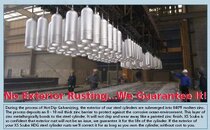Hey V:
Here's the deal on the exterior finishes:
Hot Dip Galvanization
1. All currently manufactured models of Worthington cylinders, except LP77.
2. The cylinder is submerged in 840 degree zinc alloy for about 10 minutes.
3. The cylinder is manufactured in Canada, shipped to the US for HDG, then shipped to XS Scuba or Sea Pearls.
4. Without doubt the best, longest lasting exterior finish to prevent rusting on a steel scuba cylinder (as example posted by captain, 50 years without exterior rusting).
5. Relatively expensive for the HDG process and double shipping costs.
Cold Spray Galvanization
1. Only the LP77 model.
2. The cylinder is grit blasted to bare metal, primed and sprayed with zinc rich exterior finish.
3. The cylinder is manufactured and cold galvanized in Canada, then shipped to XS Scuba or Sea Pearls.
4. An excellent, long lasting exterior finish.
5. Less expensive and no double shipping costs.
Several years ago, when we started the steel cylinder program with Worthington we evaluated many different exterior finishes. One of these is the current cold galvanizing process on the LP77. Nearly three years ago we cold galvanized a couple of LP95. After the galvanizing process, one of the cylinders was beat hard with 3/8 BBB chain to simulate the wear and tear of years of diving. Both cylinders were given to my old partner in the scuba charter boat business in Long Beach, California. Both of these cylinders continue to "live" on the back deck of his 65' charter boat. No love is given to these cylinders. They're on the back deck 24/7, exposed to the salt water/spray and direct sun. They are still there, used on an average of 20 dives per month. I've even asked them to avoid hosing them off when the back deck is washed. They remain rust free, even the cylinder we beat with a chain.
So, last year we started a project to offer a steel cylinder (LP77) that could compete with an aluminum 80 from all perspectives, including price. We choose the cold galvanizing process of the excellent results of the testing and the cost savings.
So, that's the whole story.
Both exterior finishes are covered by our Lifetime No Rust Guarantee (attached).
volyblmn:
I was curious if there were any pros or cons to either method of galvanized steel tanks. I see most tanks are now hot-dipped but a few (like the LP-77 in the deals forum) is cold galvanized. What makes one better than the other? Or is this another one of those "personal preference" type things?





